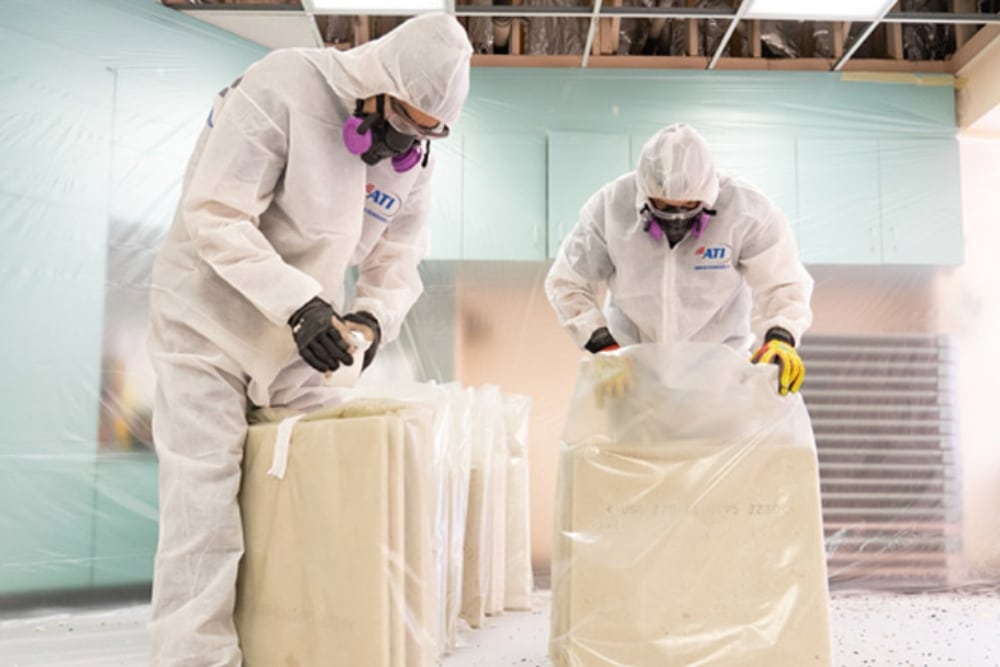Asbestos removal is a necessary and complex process for homeowners wanting to maintain a safe living environment. At My Insulation Company, we understand the importance of creating safe, asbestos-free spaces in your home. Although asbestos was once a popular building material, its dangers have been well-documented, with links to severe health issues such as lung cancer and mesothelioma.
This awareness has led many homeowners to prioritise asbestos removal when it is found in older homes. However, understanding the total cost of asbestos removal is essential, as it involves various expenses, and budgeting for this process requires strategic planning. Here’s an in-depth guide from My Insulation Company to understanding asbestos removal costs and practical tips to help you plan and budget efficiently.
Breaking Down the Cost of Asbestos Removal
The total asbestos cleaning cost varies significantly based on factors like the size of the area, the type of material, and the location of asbestos in your home. Typically, asbestos removal costs range between $20 to $65 per square foot, but let’s look at some specific expenses:-
Initial Inspection and Testing
Before beginning the asbestos removal process, a certified asbestos inspector is needed to verify asbestos presence and determine its extent. This inspection generally costs between $200 and $800, and lab testing for samples may cost an additional $20 to $100 per sample. Accurate identification and assessment are crucial for budgeting and ensuring the asbestos cleaning cost aligns with your home’s needs.
Asbestos Removal Costs
- Floor Tiles and Sheet Vinyl— Removing these materials can cost around $5 to $15 per square foot, especially if the asbestos is contained within flooring adhesives.
- Popcorn Ceilings- Often found in homes built in the 1950s-1980s, removing asbestos-laden popcorn ceilings costs approximately $3 to $7 per square foot.
- Pipe Insulation– Asbestos insulation on pipes, typically found in basements and attics, is more labour-intensive to remove and usually costs around $15 to $50 per linear foot.
Disposal Fees
Because asbestos is hazardous, it must be handled and disposed of properly. Licensed asbestos removal professionals follow strict disposal protocols, with associated fees ranging from $300 to $700. This cost covers the transportation and handling required for disposal at approved hazardous waste facilities.
Post-Removal Air Quality Testing
After asbestos removal, air quality testing ensures the area is free from harmful asbestos fibres. This essential step generally costs between $200 and $500, providing assurance that your home is safe for reoccupation.
Restoration Costs
Removing asbestos can sometimes result in damage to walls, ceilings, or flooring, especially in areas with old insulation removal needs. Restoration costs for replacing these materials vary greatly, potentially ranging from $500 to several thousand dollars. Homeowners should consider these expenses when budgeting for asbestos removal to account for any necessary repairs.
Budgeting Tips for Asbestos Removal
Asbestos removal can be a significant expense, but with careful budgeting, you can make the process more manageable. Here are some tips to help you prepare financially:
1. Get Multiple Quotes
Obtaining quotes from several licensed contractors is one of the best ways to estimate asbestos removal costs accurately. Each contractor should provide a detailed breakdown of the project scope, including inspection, removal, disposal, and restoration costs. This comparison will give you a clear view of the average asbestos cleaning cost and ensure you’re receiving fair pricing for the services provided.
2. Explore Financial Assistance Programs
In some cases, state or local governments may offer financial assistance programs or grants to help cover the cost of asbestos removal. For low-income households, these programs can significantly reduce out-of-pocket expenses. Check with your local health department or environmental agency for information on available assistance.
3. Plan for Unexpected Costs with a Contingency Fund
Asbestos removal projects often reveal other issues that need attention, like hidden mould, structural damage, or additional asbestos-containing materials. To prevent financial strain, set aside 10-15% of your total budget as a contingency fund. This extra cushion allows you to cover unexpected costs without impacting other aspects of your project.
4. Consider Partial Removal or Encapsulation
Complete removal of asbestos may not always be necessary or affordable. In some cases, encapsulation—sealing the asbestos material to prevent fiber release—can serve as a safe, budget-friendly option. This method is less labor-intensive and costs less than full old insulation removal but should only be performed by a licensed contractor who can confirm it’s a viable alternative for your situation.
5. Account for Post-Removal and Restoration Costs
Ensure your budget includes costs for post-removal air quality testing and any required restoration work. Air testing guarantees that the area is asbestos-free and safe for re-entry, while restoration ensures your home returns to its original condition. By budgeting for these steps, you avoid unexpected expenses and ensure a complete asbestos removal process.
Planning Tips for Safe and Effective Asbestos Removal
In addition to budgeting, proper planning ensures that asbestos removal is performed safely and effectively. Here’s how to prepare for a smooth asbestos abatement project:-
1. Hire Licensed and Experienced Professionals
Asbestos removal is dangerous and should never be attempted as a DIY project. Only certified professionals possess the equipment, expertise, and training required to handle asbestos safely. Look for a contractor with a strong reputation, proper licensing, and positive client reviews. Verify credentials through your state’s licensing board or environmental agency to ensure compliance with local regulations.
2. Plan for Temporary Relocation
Because asbestos removal releases fibers into the air, it’s generally recommended that all residents vacate the property for the project’s duration. Arrange for temporary housing, particularly if you have young children, elderly family members, or individuals with respiratory issues, as these groups are more vulnerable to airborne contaminants. Typically, spring or summer is an ideal time for old insulation removal and asbestos cleaning as it allows for better ventilation during and after the process.
3. Prioritize High-Risk Areas for Removal
If your home contains asbestos in multiple areas but your budget is limited, consider addressing the highest-risk areas first. Materials like damaged pipe insulation or worn flooring pose a greater threat of fibre release and should be removed as a priority. Consult with your inspector to identify which areas need immediate attention and which may be safely deferred until your budget allows.
4. Understand Local Asbestos Removal Regulations
Asbestos abatement is strictly regulated, and specific rules govern how asbestos is removed, handled, and disposed of. Some states require permits or notifications to be submitted before starting removal, while others have strict guidelines for hazardous waste disposal. Your contractor should be familiar with these requirements, but it’s always helpful to review them yourself to avoid any potential penalties.
FAQ’s
What is the average cost of asbestos removal?
The cost of asbestos removal varies depending on factors such as the size of the area, the material type, and the location of the asbestos. Generally, asbestos removal costs range between $20 to $65 per square foot. However, costs for specific materials like popcorn ceilings, floor tiles, and pipe insulation may differ.
How can I budget effectively for asbestos removal?
To budget effectively, start by obtaining multiple quotes from licensed contractors to get an accurate asbestos removal cost estimate. It’s also wise to set aside 10-15% of your budget for unexpected expenses and to include post-removal testing and restoration costs in your financial planning.
Is there financial assistance available for asbestos removal?
Yes, some local or state governments offer financial assistance or grants to help cover the cost of asbestos cleaning, particularly for low-income households. You can check with your local health department or environmental agency to see if such programs are available in your area.
Can asbestos be safely encapsulated instead of removed?
In some cases, asbestos can be safely encapsulated (sealed) instead of fully removed, especially if it’s in a stable condition. This option can reduce old insulation removal costs and is often less labour-intensive. However, this approach should only be carried out by licensed professionals after a thorough assessment of the material’s condition.
What steps should I take to ensure safe asbestos removal?
To ensure safe removal, always hire licensed professionals, plan for temporary relocation if necessary, and prioritise high-risk asbestos areas. Additionally, be sure to adhere to local regulations for asbestos abatement and arrange for post-removal air quality testing to confirm a safe environment.
Conclusion
While asbestos removal is a substantial expense, it’s an investment in your family’s health and the long-term safety of your property. At My Insulation Company, we believe that with careful planning and budgeting, you can approach this project with confidence. Start by obtaining multiple quotes, explore financial assistance options, and create a well-rounded budget that includes post-removal and restoration expenses. Prioritising high-risk areas for removal and hiring qualified professionals will ensure your asbestos abatement project is completed safely and effectively.
Asbestos removal may seem overwhelming, but taking a structured, step-by-step approach can make it manageable. With guidance from My Insulation Company, proper planning and budgeting will not only safeguard your finances but also ensure a safe and lasting solution to your home’s asbestos risks.

